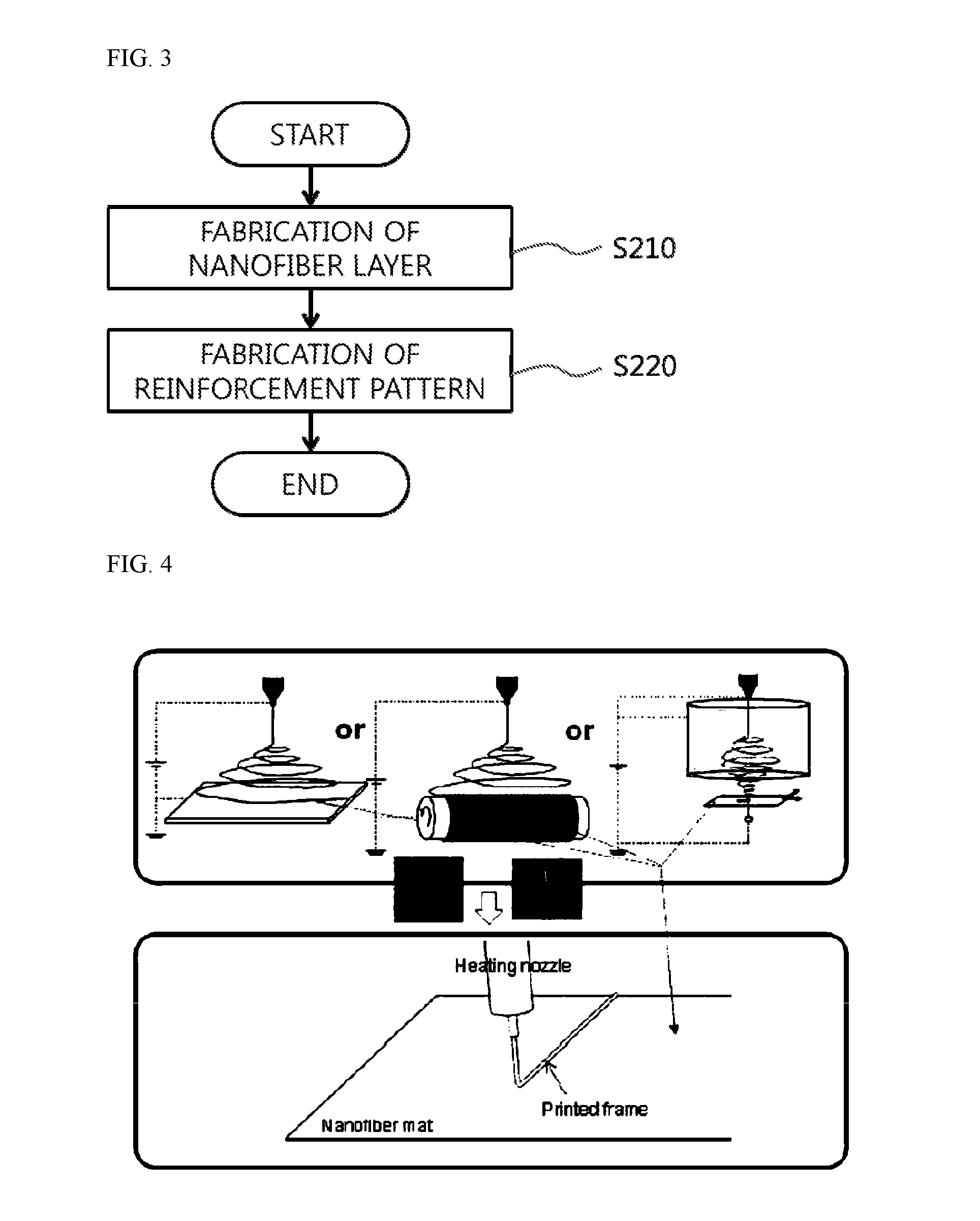Nanofiber mats, method of manufacturing the nanofiber mats, and applications to cell culture and nanofibrous membrane for guided bone regeneration
a nanofiber and mat technology, applied in the field of nanofiber mats, can solve the problems of increased cost, limited application range, and difficult handling of the material, and achieve the effects of high flexibility and elasticity for the ease of handling, sufficient structural reinforcement, and improved rigidity
- Summary
- Abstract
- Description
- Claims
- Application Information
AI Technical Summary
Benefits of technology
Problems solved by technology
Method used
Image
Examples
example 1
[0118]A 9 wt % solution prepared by dissolving PCL with a number average molecular weight (Mn) of about 80,000 in chloroform was electrospun to a 150-μm thick glass collector under process conditions including a spinning distance (nozzle-to-collector distance) of 70 mm, voltage of 20 kV, and a flow rate of 0.1 ml / h. On the produced nanofibers, a reinforcement pattern was printed by an FDM process and using a PCL-melt under process conditions including a temperature of 100° C., pressure of 600 kPa, scanning speed of 100 mm / min, nozzle diameter of 150 μm, and a jetting distance of 150 μm. A thickness of the obtained nanofiber mat was 100 μm, and a diameter of the reinforcement was 150 μm.
example 2
[0119]A 9 wt % solution prepared by dissolving PCL with a Mn of about 80,000 in chloroform was electrospun to a drum-shaped collection screen, which rotates at 3000 rpm, under process conditions including a spinning distance of 70 mm, voltage of 20 kV, and a flow rate of 0.1 ml / h. After spinning, the cylindrical nanofiber was cut flat. On the produced nanofibers, a reinforcement pattern was printed by an FDM process and using a PCL-melt under process conditions including a temperature of 100° C., pressure of 600 kPa, scanning speed of 100 mm / min, nozzle diameter of 150 μm, and a jetting distance of 150 μm. A thickness of the obtained nanofiber mat was 120 μm, and a diameter of the reinforcement was 150 μm.
example 3
[0120]A 9 wt % solution was prepared by dissolving 500 mg of PCL with a Mn of about 80,000 in chloroform. 10 μg of BMP-2 and 50 mg of PEG were dissolved in 2 ml of DCM, added to the PCL solution previously prepared, and stirred thoroughly for 30 minutes. Then, it was electrospun to a 150-μm thick glass collector under process conditions including a spinning distance of 70 mm, voltage of 20 kV, and a flow rate of 0.1 ml / h. On the produced nanofibers, a reinforcement pattern was printed by an FDM process and using a PCL-melt under process conditions including a temperature of 100 ° C., pressure of 600 kPa, scanning speed of 100 mm / min, nozzle diameter of 150 μm, and a jetting distance of 150 μm. A thickness of the obtained nanofiber mat was 100 μm, and a diameter of the reinforcement was 150 μm.
PUM
| Property | Measurement | Unit |
|---|---|---|
| Flexibility | aaaaa | aaaaa |
| Shape | aaaaa | aaaaa |
| Stiffness | aaaaa | aaaaa |
Abstract
Description
Claims
Application Information
 Login to View More
Login to View More - R&D
- Intellectual Property
- Life Sciences
- Materials
- Tech Scout
- Unparalleled Data Quality
- Higher Quality Content
- 60% Fewer Hallucinations
Browse by: Latest US Patents, China's latest patents, Technical Efficacy Thesaurus, Application Domain, Technology Topic, Popular Technical Reports.
© 2025 PatSnap. All rights reserved.Legal|Privacy policy|Modern Slavery Act Transparency Statement|Sitemap|About US| Contact US: help@patsnap.com



